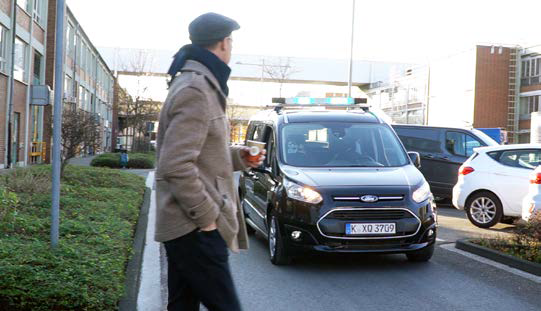
- Behavioural analysis for a new “ecosystem”

UMA starts its studies to promote “informed” acceptance of autonomous driving and to guide decision-makers’ choices.
The European project PAsCAL is in full swing. As scheduled, accurate analysis is being carried out to understand the actual level of knowledge and acceptance of autonomous driving among European citizens. Indeed, fostering the deployment of autonomous and connected mobility solutions, by ‘attracting’ potential users to new technologies, is among the main goals of the project (see previous articles in Onda Verde n. 24 and n. 25).
In this framework, the University of Mannheim (UMA) – a partner of the PAsCAL project – has taken on the task to analyse, from a behavioural psychology standpoint, the current citizens’ perception and the criteria that can foster full acceptance of the mobility solutions. Behavioural psychology is the study of human behaviour and its cognitive processes while interacting with the environment and other human beings.
To better understand the methodology and the specific goals of this analysis, Onda Verde has interviewed Celina Kacperski, a researcher at UMA Consumers Psychology Dept, who is working on this study in an experts team along with other two prominent researchers, Florian Kutzner and Tobias Vogel.
Which areas is your behavioural analysis being focused on?
“When it comes to autonomous mobility, it is self-steering and self-braking car that springs to most people’s mind. Nevertheless, this type of mobility solution based on the most common and widespread ‘owned car’ model is just one of the many solutions studied in the UMA team, under the PAsCAL project. We are also studying shared vehicles, including not only car sharing but also small buses that can be booked via app, larger self-driving buses travelling along fixed routes, emergency vehicles and autonomous drone-taxis.”
What are the main aspects to be considered?
“To guarantee these autonomous-driving solutions be effectively deployed two essential aspects must be taken into account: do European citizens accept these mobility solutions? If yes, how to design them in the most user-friendly way?”
Let’s start from the first aspect: how to promote acceptance among potential users?
“The first aspect concerns what can be defined “informed” acceptance. It is possible to understand to what extent the solution is accepted only after making it realistic through, for instance, images, pictures, simulations and after explaining its consequences, for example, its costs or environmental impact. We must also bear in mind that mobility is an ecosystem made of different coexisting participants, so it is essential to analyse the acceptance not only of potential autonomous vehicles users but also of other road users, such as cyclists and pedestrians, who share the same space but do not use autonomous vehicles.”
What about the second aspect, the user-friendliness?
" As to this aspect it is very important to segment users by their purposes and abilities. We are studying how to make all automated solutions available to people of all ages and genders, including particularly vulnerable categories such as the visually impaired and the blind. All these potential users can have different requirements, such as the need for special or tailored interfaces or additional safety measures. Moreover, they can use connected and automated vehicles for different purposes."
What are the most efficient methodologies to ensure this is a successful research?
"The methodologies that we will use at different stages of the PAsCAL project are based both on quality and quantity parameters. For instance, we will first conduct semi-structured interviews with stakeholder experts. A semi-structured interview is a research methodology consisting in an interview on a set of predetermined questions which leave space to different “paths”, with the aim of getting from participants either a choice among predetermined answers and new ideas. In such interviews, part of the questions are open, while survey-type questions are also included, to get more information about the users’ mental process in case new ideas come up. Therefore, these interviews will give us some initial insights on the potential triggers/hurdles to public acceptance as well as a picture of possible scenarios for autonomous vehicles in a number of different contexts, including possible effects of these vehicles on society and environment."
Can you give us some examples?
"For instance, if an interviewed said: " It would be easy for me to learn to drive an autonomous car on a highway", the next question would be: "As regards autonomous vehicles, in your opinion to what extent the following benefits would follow: less accidents, less serious accidents, faster emergency services response time, less traffic congestion, faster travels, less CO2 emissions, fuel savings … ?" Or either, focusing on another target, if an interviewed said "My interaction with an autonomous shuttle would be clear and understandable", the next question would be: "What would you do in an autonomous vehicle: sleep/rest, listen to music, use a mobile phone, check your email, watch a film, read, eat/drink, talk with other passengers, watch the view outside the car … ?“
Once these interviews are completed, what are the next steps in your research programme?
"These interviews will provide additional and more focused information that is needed to conduct two large-scale surveys in the next steps of the PAsCAL project. These additional surveys will be directed to thousands of participants from four EU countries. Furthermore, all data collected through the mentioned activities will be complemented by research done with the help of driving simulators. Contributions from all those sources will be finally processed and summarized into an open document, freely accessible on the Internet, named "Guide2Autonomy". Such document will be basically designed to provide decision-makers with the information they need to adopt regulations on the new technologies and guide their implementation on the road, not only for the benefit of future drivers but also of all other mobility players."